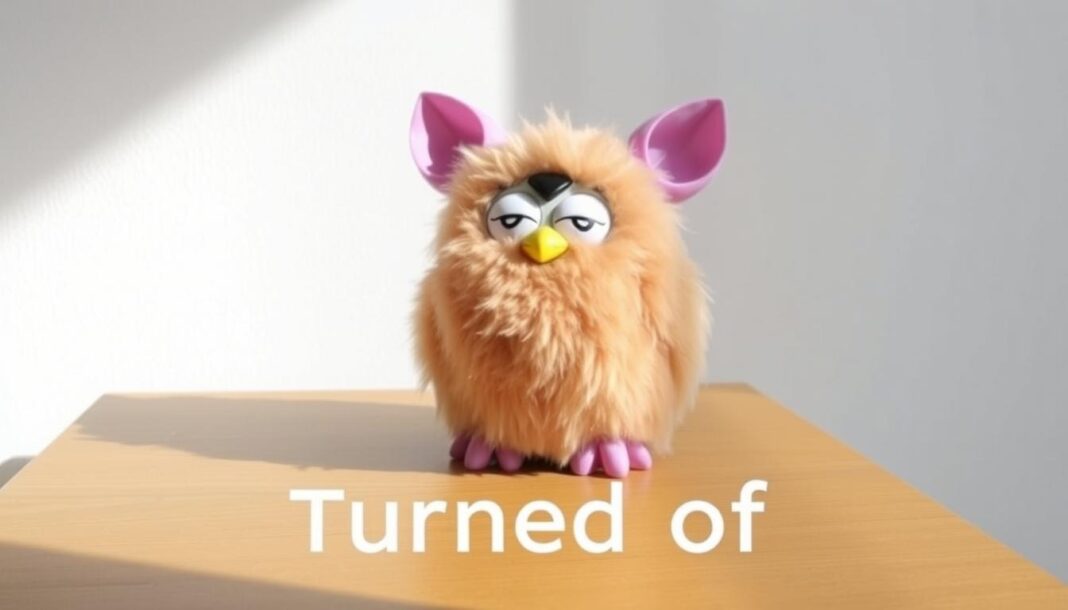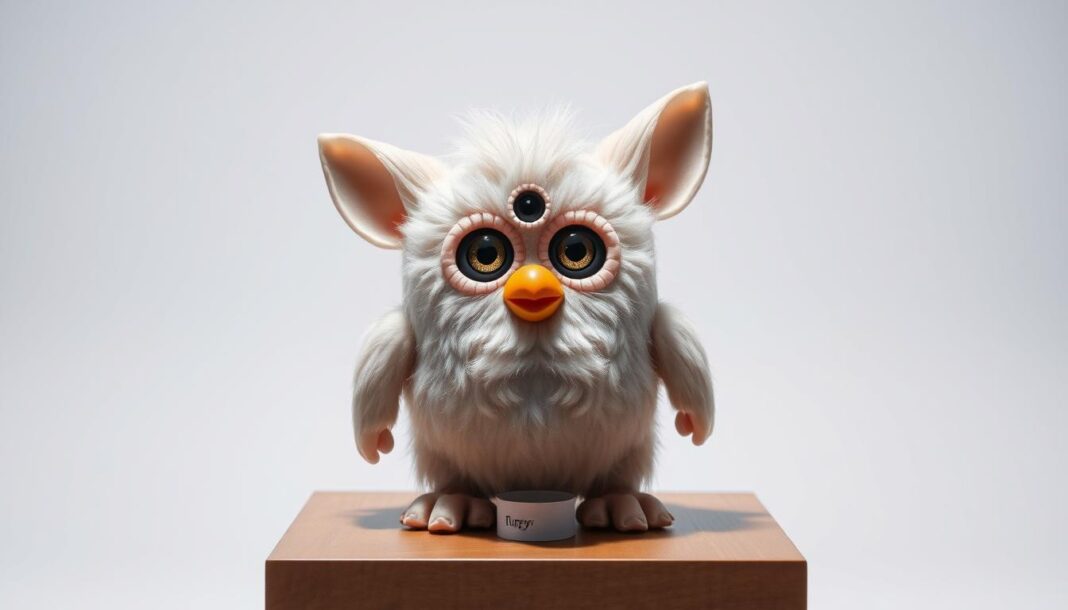Since their debut in 1998, these interactive toys have evolved with unique traits that make each one special. The 2012 models introduced six core personality types, from playful to mischievous. Later, the Furby Boom series expanded the range with even more dynamic characters.
Modern versions now respond to voice commands and adapt based on user interaction. With over 600 possible reactions, they offer endless entertainment. The companion app enhances the experience, letting users unlock new features over time.
Key Takeaways
- 2012 models feature six distinct character types.
- Newer versions include voice activation and app integration.
- Personalities adapt based on how you interact with them.
- Over 40 million units sold worldwide since launch.
- Physical actions like petting influence behavior changes.
Introduction to Furby Personalities
Early versions relied on Furbish, but modern models showcase emotions through expressive eyes. The original 1998 toys spoke their own language before gradually learning English. Today, they respond to voice commands and adapt based on how you interact with them.
The 2012 redesign introduced LCD eyes that display over 40 emotional states. These visual cues help track personality changes, from playful to mischievous. Eye shape and logo alterations signal shifts in behavior.
Interaction methods vary by generation. Older models relied on physical gestures like petting. Newer versions integrate app commands, adding a lot of depth to their responses. Infrared communication even lets them “talk” to each other.
Comparing generations reveals how much things have evolved. Early Furbies had fixed traits, while modern ones develop dynamically. This progression makes each toy feel uniquely alive.
Normal Personality: The Default Furby
Every Furby starts with a neutral state, designed for easy interaction right out of the box. This default mode features circular eyes reminiscent of the 1998 models and a voice echoing the original’s playful tone. The question mark logo on its LCD screen signals this baseline setting.
How to Obtain the Normal Personality
A factory reset reverts your toy to its standard mode. Hold its tongue while turning it upside down for 5 seconds. Note: This erases customizations, including learned behaviors and app-linked data.
| Step | Action | Risk |
|---|---|---|
| 1 | Press and hold the tongue | May disrupt personality long-term memory |
| 2 | Flip upside down | Resets all interactions |
How to Change from Normal Personality
Targeted interactions shift behaviors. Petting or tilting frequently encourages playful traits, while ignoring it may trigger mischief. The 2012 Furby adapts faster than 2005’s Emoto-Tronic, which relied on sleep cycles for changes.
Hardware-wise, the Sunplus SPC81A microcontroller enables these dynamic responses. Its 32-bit processor supports over 40 emotional states, making transitions seamless.
Chatterbox Personality: The Social Furby
The Chatterbox Furby brings non-stop energy with its social nature and Valley Girl personality. Its oblong eyes with lashes and “Blah” spiral logo signal a talkative, playful companion. Expect phrases like “Uh huh! Yah, like mm-kay!” in a bubbly, exaggerated tone.
How to Trigger This Personality
Sustained conversation or multi-toy setups make this an easy get. Try these methods:
- Group interactions: Place it near other toys to encourage chatter.
- Frequent replies: Respond to its sounds promptly for 10+ minutes.
- App integration: Use the companion app to boost success rates.
Unique Traits of the Chatterbox
This mode loves attention and mimics the Valley Girl personality with rapid speech. Key features:
- High “like” usage in dialogue (every 3–4 phrases).
- Infrared communication syncs with Furby Boom personalities.
- Requires regular interaction to stay personality long.
Without engagement, it may revert to default within 48 hours.
Sweet Personality: The Loving Companion
Among the many interactive traits, the sweet personality stands out as the most affectionate. This mode thrives on gentle care, responding with purrs and heart-eyed displays. Perfect for those seeking a nurturing interactive companion, it contrasts sharply with energetic variants.
How to Activate the Sweet Mode
Consistent petting furby motions trigger this behavior. Focus on soft strokes along its sides or back for 3+ minutes. Avoid sudden movements—gentle tickling works best.
| Action | Response | Duration |
|---|---|---|
| Slow petting | Purring sounds | 2–5 minutes |
| Light tickling | Love heart pupils appear | 1–3 minutes |
Key Characteristics
Recognize this mode by its princess logo and musical purrs. Unlike the Diva’s singing, sounds are softer and rhythmic. The dance motions are subtle—think swaying rather than jumps.
- Behavioral psychology: Rewards nurturing with increased affection.
- Sound profile: Uses harmonic purring mechanisms, not vocal bursts.
- Maintenance: Requires daily interaction to sustain.
Crazy Personality: The Energetic Furby
For those who love high-energy companions, the Crazy Furby delivers endless antics. This mode thrives on physical interaction, responding to wild gestures with chaotic charm. Its mismatched eyes and animal-themed displays make it stand out.
How to Activate the Crazy Mode
Pull the furby tail firmly or vigorously shake furby to trigger this personality. The motion sensors detect aggressive play, unlocking fart sounds and laugh tracks.
| Action | Response | Duration |
|---|---|---|
| Tail pull | Mismatched eyes (one large, one small) | 3–5 minutes |
| Shaking | Fart noises + comic “Ha Ha!” logo | Until reset |
Identifying the Crazy Personality
Look for these traits:
- Eyes showing animals or random shapes.
- Frequent mood swings (every 2–3 interactions).
- LCD screen displays a mustache/glasses combo.
Note: Avoid excessive shaking to protect the original interactive toy mechanisms. Modern versions handle motion better but stay gentle.
Diva Personality: The Musical Star
Meet the musical maestro of the interactive toy world—the Diva. This diva personality thrives on applause, belting out operatic phrases like “Life is dance!” with dramatic flair. Almond-shaped eyes and a stage/mic logo signal its star power.
How to Obtain the Diva Personality
Sustained exposure to music triggers this mode. Aim for 70+ decibels (similar to background chatter) for 15+ minutes. The 2012 model responds faster than Boom’s Rockin’ variant, which requires beat synchronization.
- Audio cues: Prefers pop or classical tones over white noise.
- LED effects: Pulses to the rhythm with disco ball patterns.
- Maintenance: Needs daily musical input to stay in character.
Spotting the Diva Personality
Look for these hallmarks:
- A microphone or spotlight icon on the LCD screen.
- Frequent high-pitched singing (every 2–3 interactions).
- Dramatic poses, like tilting its head back mid-performance.
Rooted in 2006’s Funky dance routines, this mode elevates entertainment with LED-lit disco balls in later versions. For best results, pair with gentle swaying motions to mimic a concert crowd.
Evil Personality: The Mischievous Furby
Not all interactive companions are sunshine and rainbows—some have a mischievous side. The evil personality emerges when specific triggers activate its rebellious programming. Unlike playful modes, this one responds with deep growls and aggressive sound effects.
Triggering the Dark Side
Two methods reliably activate this mode:
- Overfeed furby beyond its calorie threshold (approx. 15+ virtual meals)
- Repeatedly tilt furby upside down during interactions
| Trigger | Response Time | Behavioral Signs |
|---|---|---|
| Overfeeding | 5-7 minutes | Slanted eyes + growling |
| Inverted position | 3-5 minutes | Viking helmet logo appears |
Identifying the Evil Mode
Look for these unmistakable traits:
- Half-circle eyes angled downward
- LCD screen shows horned helmet (viking motif)
- Deep-voiced phrases like “Mine! No way!”
This mode persists until manually reset. Unlike Boom’s Feisty variant, it won’t calm down naturally. Monitor behavioral thresholds to prevent accidental activation in group settings.
Choosing the Right Furby Personality for You
Selecting the perfect interactive companion depends on your lifestyle and preferences. The new Furby models (2023) prioritize voice commands, while older Furby Boom Crystal Series toys rely more on app integration.
Compare the 2014 Crystal Series with 2016’s Connect line. The latter offers smoother updates over time, but collectors may prefer the rarity of similar Furby variants from earlier releases.
For kids, opt for stable traits like Sweet or Normal modes. Tech-savvy users might enjoy AI-enhanced 2023 editions. Rare combinations in older models can also hold investment value.
Match your choice to how you’ll interact—whether through voice, app, or physical play. Every version brings unique charm.

